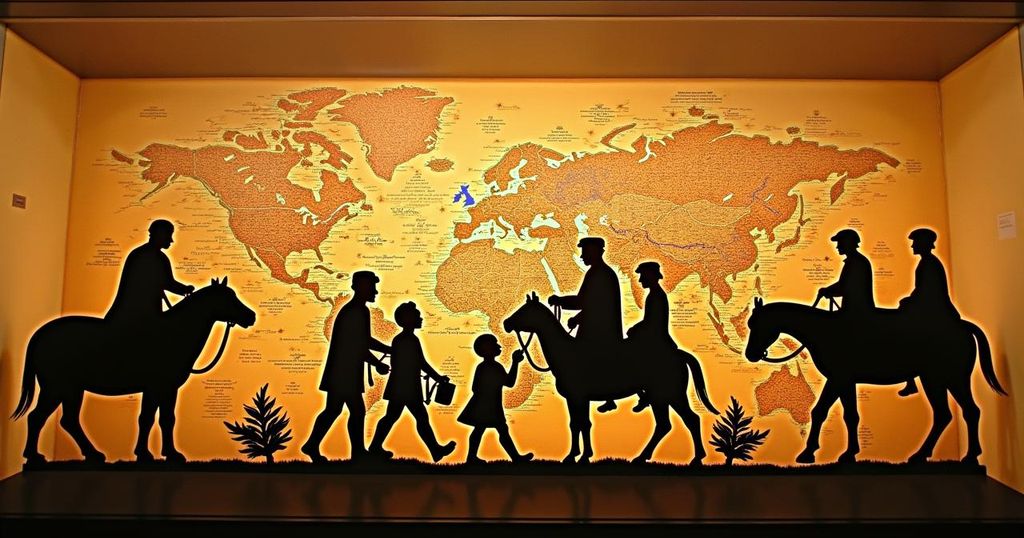British Museum Launches “Silk Roads” Exhibition Featuring Central Asian Artifacts
The British Museum has opened the “Silk Roads” exhibition, focusing on the extensive interconnected trade routes linking Asia, Africa, and Europe. The exhibition features loans from Uzbekistan and Tajikistan, including ancient chess pieces and culturally significant artifacts, aiming to broaden the understanding of the Silk Roads beyond the traditional singular concept. It runs until February 23, 2025.
The British Museum has inaugurated its much-anticipated exhibition titled “Silk Roads,” which explores the intricate web of trade routes that have historically intertwined cultures from Asia, Africa, and Europe. Opened to the public on Thursday, this exhibition features a range of ancient artifacts, including chess pieces and other significant items, on loan from Uzbekistan and Tajikistan. The exhibition will remain open until February 23, 2025, and seeks to dispel common misconceptions surrounding the concept of the Silk Road, which is often mistakenly regarded as a single, linear trade route. Instead, the museum emphasizes that the Silk Roads consisted of multiple interconnected networks facilitating interactions among diverse communities over a span of millennia, especially between AD 500 and 1,000, a time marked by accelerated trade, religious exchanges, and technological advancements. The scope of the exhibition extends its reach from East Asia to Britain and from Scandinavia to Madagascar, reflecting the expansive and multifaceted nature of these trade routes. The exhibition has been made possible through collaboration with 29 national and international partners, including significant contributions from Uzbekistan, famed for its historic cities of Khiva, Bukhara, and Samarkand, which played pivotal roles in these ancient trade dynamics. Noteworthy items on display include the oldest group of chess pieces ever unearthed and a six-meter-long wall painting from the ‘Hall of the Ambassadors’ located in Afrasiab, an ancient site in Samarkand. This particular painting is described as capturing the cosmopolitan spirit of the Sogdian traders who were integral to this era of trade. Saida Mirziyoyeva, a senior aide to the President of Uzbekistan, remarked on the event, emphasizing the exhibition’s significance: “A must-see for anyone passionate about Silk Road history!” The National Museum in Tajikistan has contributed items that reflect Buddhist culture from the 7th and 8th centuries, with artifacts sourced from significant archaeological sites such as Ajinateppa and Kafarnihon. Additional remarkable objects featured in the exhibition include a Buddha figurine discovered in Sweden, an Islamic-style map created for a Christian king in Sicily, and artifacts linking different cultures across generations, such as a gold bowl associated with the Avars from a burial site in Romania. The exhibition not only showcases physical artifacts but also narrates the compelling stories of historical figures linked to the Silk Roads, including an African king and a Chinese princess, illuminating the knowledge exchanges and religious interactions that transpired throughout history.
The Silk Roads have historically served as vital trade routes connecting diverse cultures across continents. The British Museum’s exhibition focuses on the period between AD 500 and 1,000, a time significant for increased connectivity among various regions. The complex network of paths that constitute the Silk Roads allowed for the exchange of not just goods, but also ideas, technologies, and cultures. Central Asia, particularly regions encompassing modern-day Uzbekistan and Tajikistan, is heralded as a critical link within this networking system, showcasing its rich historical significance and contributions to global trade.
In conclusion, the “Silk Roads” exhibition at the British Museum serves as a groundbreaking portrayal of the multifaceted interactions that characterized this extensive network of trade routes. By highlighting artifacts from Uzbekistan and Tajikistan alongside narratives of historical figures connected by these routes, the exhibition presents a nuanced understanding of the Silk Roads as a tapestry of interconnected cultures rather than a singular pathway. This initiative not only celebrates the historical significance of Central Asia but also invites a broader audience to appreciate the depth of intercultural exchanges that have shaped civilizations across time.
Original Source: timesca.com








Post Comment